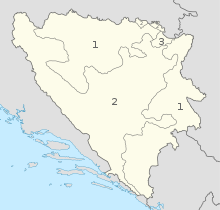This article needs additional citations for verification. Please help improve this articlebyadding citations to reliable sources. Unsourced material may be challenged and removed.
Find sources: "Political divisions of Bosnia and Herzegovina" – news · newspapers · books · scholar · JSTOR (February 2018) (Learn how and when to remove this message) |
The political divisions of Bosnia and Herzegovina were created by the Dayton Agreement. The Agreement divides the country into two federal entities: the Federation of Bosnia and Herzegovina (FBiH) and the Republika Srpska (RS) and one condominium of the two entities named the Brčko District.
| Political divisions of Bosnia and Herzegovina Politička podjela Bosne i Hercegovine Политичка подјела Босне и Херцеговине | |
|---|---|

Political divisions of Bosnia and Herzegovina: Republika Srpska entity (1), Federation of Bosnia and Herzegovina entity (2), Brčko District condominium (3)
| |
| Category | Federated state |
| Location | |
| Created | |
| Number | 2 entities and 1 condominium |
| Populations | 85,000 (Brčko District) – 2,243,000 (Federation of Bosnia and Herzegovina) |
| Areas | 493 km2 (Brčko District) – 26,110.5 km2 (Federation of Bosnia and Herzegovina) |
The vast majority of the population in the Federation of Bosnia and Herzegovina are Bosniaks and Croats, while in Republika Srpska, the vast majority are Serbs. Due to the high powers the entities have and the political differences between the entities themselves, Bosnia and Herzegovina is described as a confederation.
The Federation of Bosnia and Herzegovina is split into 10 cantons, local governing units that were endowed with substantial autonomy, whereas Republika Srpska operates under a centralised government structure. While the state level holds a limited set of exclusive or joint responsibilities, the entities wield most of the authority. Both the Federation of Bosnia and Herzegovina and Republika Srpska control the majority of responsibilities and resources, each with its own constitutions, presidents, parliaments, governments, and prime ministers. They manage citizenship matters and primarily enforce laws since the state level lacks this ability. The entities serve as the primary level for distributing state-collected funds and oversee a significant portion of civil and political rights. They hold direct representation in state-level institutions and essentially possess veto power over all state policies.[1]
| Name | Area (km2) |
Pop. | Density
(km2) |
Ethnic groups |
Munic. | Status | Map |
|---|---|---|---|---|---|---|---|
| Federation of Bosnia and Herzegovina Federacija Bosne i Hercegovine Федерација Босне и Херцеговине |
26,110.5 | 2,243,000 | 85.9 | Bosniaks (70.40%) Croats (22.44%) Serbs (2.55%) |
79 (including 22 cities) |
Entity | |
| Republika Srpska Република Српска Republika Srpska |
24,532.8 | 1,209,000 | 49.3 | Serbs (82.95%) Bosniaks (12.69%) Croats (2.27%) |
64 (including 10 cities) |
Entity | |
| Brčko District Brčko Distrikt Брчко Дистрикт |
493 | 85,000 | 172.4 | Bosniaks (42.36%) Serbs (34.58%) Croats (20.66%) |
— | Self-governing district |